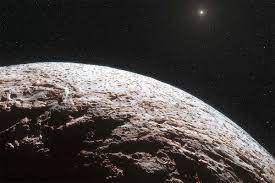Cosmic objects with strange orbits discovered beyond Neptune
- Sri Sairam Gautam B
- Sep 17, 2021
- 3 min read
After six years of searching beyond Neptune's orbit, 461 recently discovered objects were discovered.
These items include four that are more than 230 astronomical units (UA) of the sun. (An astronomy unit is a distance between the Earth and the Sun, about 93 million miles or 149.6 million kilometers). These extraordinarily distant objects might shed light on Planet Nine, a theoretical, never-observed body that might be hiding in deep space, its gravity affecting the orbits of some of the rocky objects at the solar system's edge.
The new observations are provided by the Dark Energy Survey, an effort to map the galactic structure of the universe and dark matter that began in 2013. Six years of observation from the Blanco Telescope in Cerro Tololo in Chile yielded a total of 817 confirmed new objects, 461 of which are now being described for the first time in a paper posted on the preprint server arXiv. ScienceAlert reports that the article was peer-reviewed.

The objects of the study are all at least 30 AU, in a part of the solar system, which is almost incredibly dark and solitary. More than 3,000 transneptunian objects, or TNO, have been identified on these icy stretches. These include dwarf planets such as Pluto and Eris and small things from the Kuiper belt such as Arrokoth, a rocking body visited by the New Horizons space probe in 2019. The Kuiper Belt is a region of icy objects orbiting around 30 UQA and 50 UQA of the sun.
Of the 461 items first described in this new document, a few stand out. Nine are known as extreme transneptunian objects whose orbits swing at least 150 AU from the sun. Four of these are incredibly powerful, with orbital distances of 230AU. At such distances, things are hardly touched by Neptune's gravity, but their strange orbits suggest an outside influence on the solar system. Some researchers believe the effect may be an unknown planet called Planet Nine. (Others think that the combined gravity of many tiny objects, or nothing more than a statistical anomaly, explains the weird orbits.) The newly discovered objects could thus help researchers hone in on the possible Planet Nine — or disprove its existence.
The scientists also found four other Neptune Trojans. Trojan horses are bodies that share an orbit with a planet or moon. In this case, the objects divide the orbit of Neptune around the sun. They also observed comet Bernardinelli-Bernstein, named after the two primary authors of the article, University of Pennsylvania cosmologist Gary Bernstein and University of Washington post-doctoral fellow Pedro Bernardinelli. The two researchers were the first to locate the comet in the Darth Energy Survey dataset. The Bernardinelli-Bernstein comet can reach 100 miles (160 kilometers) wide. It comes from the Oort cloud, another frozen object layer further afield than the Kuiper belt.

At least 155 of the newly discovered objects are what astronomers called "detached." which means that they are far enough from Neptune that the giant planet's gravity doesn't affect them much; instead, they're mostly tied to the solar system by the distant pull of the sun. Loose objects, sometimes known as large scattered disk objects, tend to have enormous elliptical orbits.
The results are exciting, the researchers wrote in their paper, because the Dark Energy Survey was not intended to investigate trans-Neptunian objects. Instead, it aimed to characterize the theoretical black energy which affects the accelerated expansion of the universe. Nonetheless, the researchers wrote that the survey data contains 20% of all currently known TNOs, covering an eighth of the sky.

"These will be invaluable for other detailed statistical tests of training models for the Trans-Neptunian region,' they wrote.




Comments